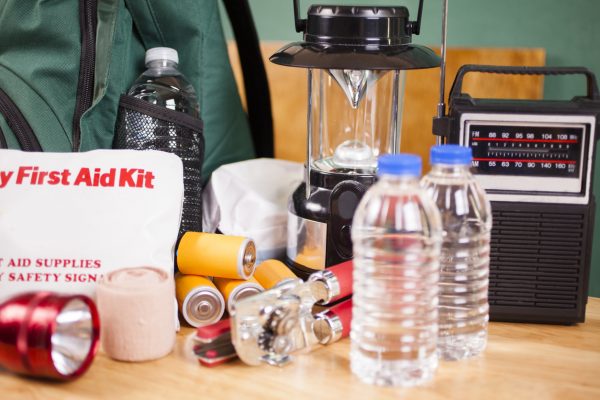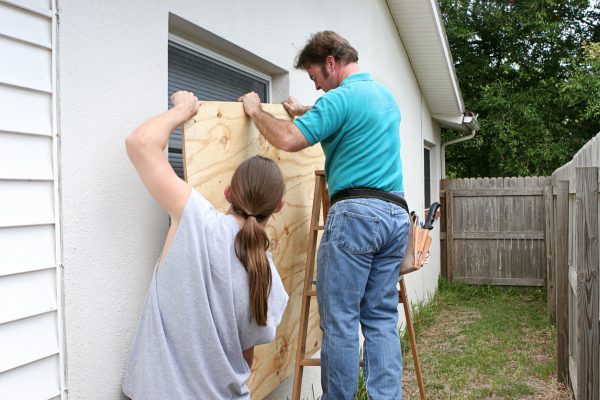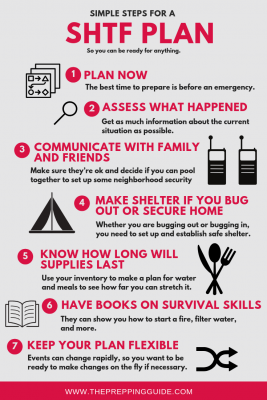Do you have a SHTF plan ready for any scenario? Are you ready for whatever comes your way? I always thought so until we were out of power for five days. Then, I realized, our family wasn’t as prepared as I hoped.
You need a plan and resources to be ready for anything. In November 2018, a magnitude 7.0 earthquake struck Anchorage, Alaska. Roads collapsed, water tanks burst, and people went without heat for days. Luckily, things quickly came under control, but could you survive without heat for a few days in the winter?
That scenario may not be a SHTF scenario for you, but it could be for someone. An even larger earthquake could knock out communications and electricity for weeks, forcing you to rely on riskier off-grid communication methods. You may have a solid everyday carry setup, but are you ready and organized for a long-term emergency?
Potential SHTF Scenarios
First, let’s take a look at SHTF scenarios. What you’re preparing for is up to you. Our family focuses on natural and personal disasters, but we desire to be prepared for anything. Prepping is all about possible scenarios and outcomes, so it’s important to use some foresight when evaluating your options and SHTF plans. It’s also important to hone your situational awareness to consider the pros, cons and risks of your various preparations and predictions.
Natural Disasters
Natural disasters are always a concern. We can do nothing to stop Mother Nature, so all we can do is prepare and survive. It might be a massive earthquake, hurricane, or wildfire.
In fact, 2018 brought all three to the United States. The Camp Fire in California was the most deadliest in United States history. We saw a huge earthquake in Alaska, and two huge hurricanes – Hurricane Florence and Hurricane Michael. These events affected millions and stole lives.
The Grid Goes Down
Many people fear a disaster that could cause the partial or complete grid to go down. That could be caused by an EMP launched at us or a natural disaster on a more local scale. Most societies won’t survive without electricity. Everything depends on it. Some cars nowadays need electricity rather than gasoline!
Economic Collapse
As the national debt continues to climb, it’s natural for people to worry about economic collapse. A look throughout history shows us many great nations and empires that fell to economic collapse, so we cannot believe that we are immune to it.
Take, for example, the economic crisis that hit Greece in 2015. Stores were empty. People were hungry, and they still feel it today, three years later.
Nuclear War or Other Attacks
Whether you’re worried about a nuclear war or a cyber attack, it’s possible that one of these events could occur in your lifetime. We live in an unstable world, especially politically.
All of these events could lead to a secondary SHTF situation – civil unrest. When people are scared and angry, it becomes a dangerous situation to be near.
It’s important to remember that a SHTF scenario can be personal, such as a job loss. If your family survives on one income, the loss of that sole income could have devastating effects. This situation is something my family prepares and plans for because we live on one income. It’s important for us to have food stored and be ready for those events.
What to Consider If You Must Leave Home
Leaving home during a SHTF scenario is called bugging out. You are leaving your home behind, and you really need a plan for these situations. The most important thing to remember is – if you bug out, so are other people. Highways might be flooded, so having several alternative routes planned is important. Although it’s not always possible, having a bug out vehicle can also help get you and your family to safety with fewer issues.
Scenarios Where You Can’t Stay Home
Certain scenarios make it more probable and safe to leave home – aka bug out. Here are a few examples of those times.
A natural disaster is imminent. Is a hurricane headed your way or a massive wildfire? If you’re in the line of danger with your family, it could be a good time to leave.
Staying home is more dangerous than leaving. Is your home right in the middle of everything? If so, it’s time to say bye!
Transportation system is affected. If your transportation system is shut down, things will go crazy. Stores will empty and people are left without food and water. It’s time to go.
Your stockpile is nearly depleted. If the disaster lasts longer than you expected and planned, take a look at your stockpile and decide if you have enough to survive until it ends. If not, it’s time for the next plan.
Where Do You Go?
Once you decide that you need to bug out, you have to decide where are you going to go. Ideally, you’d have a second property set up for these situations, but that’s not always possible. Having a bunker would be the best scenario.
If you don’t have a plan with friends or family set up, here are some things to consider when deciding where to go.
- Get off the beaten track. Try cutting down a tree to block the dirt road.
- Don’t tell everyone about your bug out location!
- Make sure there is a water source nearby
- Decide about a heat source
- It should be 10 to 20 miles away from a village for additional supplies or contact from outside world.
- Land to grow your own veggies and crops
What Are You Bringing With You
You need supplies to bug out, but you’re limited by what you can carry. So, everything has to have a purpose. Having a list prepared and bug out bags ready to go is crucial. You don’t want to forget something important in the scramble to leave. For a complete list for your bug out bag, check out a list of essentials here.
- Water and water filtration methods
- Food – protein bars, nuts, freeze-dried options and high in calorie items.
- First aid kit
- Necessary medications
- Duct tape
- Rope
- Tent
- Fire Starter
- Hand crank radio
- Emergency foil blankets
- Extra clothes, especially socks and gloves. Don’t forget a hat.
- Knife
- Dust mask
- Multi-function tool
If you’re living or venturing to areas that have been affected by chemical warfare or other environmental hazards, you may also want to consider military-grade gas masks, nuclear gas masks or simple dust masks.
How Do You Survive in the Wild?
You have four main concerns if you want to survive in the wild when you bug out – shelter, food, water, and medical care. Your chances of survival drop significantly without these things. Here are some suggestions.
1. Create a plan for shelter.
You should have a tent and a tarp to create a dry, safe shelter that fits everyone in your family.
2. Think about food.
A bug out bag should contain enough food for 48 to 72 hours or more. Then, you have to decide how you will source food. Can you hunt, fish, or trap? Learn how to forage in your area.
3. You need water.
Humans can survive days without food, but not very long without water. Keep water in your bug out bag, but you also want a way to filter water that you find.
4. Have a stocked first aid kit.
If you fall and are injured, you need a way to tend your wounds. Make sure you have daily medications stocked as well until you can get more.
What to Do If You Need to Stay at Home
The opposite of bugging out is bugging in, and that’s when you decide to stay put during a disaster. Many times, bugging in is the best choice, especially if you have kids. Bugging in with kids can be the best situation. Imagine trying to drag kids through the woods, in a dangerous situation.
Scenarios Where You Could Stay at Home
First, just like with bugging out, you have to decide when it’s appropriate to bug in. Here are a few scenarios to consider.
Outside is more dangerous. People start to panic when the SHTF, especially those who aren’t prepared. They’ll do whatever it takes to survive. Sometimes, being locked in your home is the best choice for survival.
You don’t have a safe destination. Staying in the woods sounds fine in theory, but know that you won’t be alone. If you don’t have a safe destination in mind, it’s best to wait it out.
It’ll be too suspicious. When you’re on the road during an emergency, you become an easier target, especially if you have kids. You don’t know who or what you’re walking into, and that makes everything stressful.
How to Set Up Your Home to Survive
Staying home is often easier than bugging out because you, at least, have a shelter prepared already – especially if you have something like an underground bunker or storm shelter. Here are some tips for bugging in preparations.
Make sure you have water stored. You want one gallon per day per person stored. Plan to have at least a week stored, but you can never have too much water stored.
Consider heat. If it’s winter, how will you safely heat your home? If the electricity is out, you might want a generator or a wood-burning stove. Propane can be dangerous in small spaces.
Decide how you will get more water. Is there a spring nearby or can you set up a water collection system?
Stock your food pantry. Since you’re bugging in, you do have more options like canned goods and other foods with long shelf lives. You can keep stuff like canned beans and soups, along with comfort items for your family.
Be ready for security. Have supplies to board up your home and weapons, if you desire, to protect it.
If you’re curious, you might want to check out the foods that last forever.
SHTF Plan Steps
1. Plan Now
The best time to prepare is before an emergency. Start buying and storing essentials now. Pick your bug out bag, create a plan for water filtering. Stock up on medical supplies, knives, tools, and whatever else you think you’ll need. If you have kids as I do, prepare for diapers and feeding supplies as well.
2. Assess What Happened
Get as much information about the current situation as possible. Keep an emergency radio so that you can listen to the news. Learning how to use ham radios is a great way to get information as well.
3. Communicate with Family and Friends
Get in touch with your friends, family, and neighbors. Make sure they’re ok and decide if you can pool together to set up some neighborhood security. It’s a good idea to talk to neighbors ahead of time to utilize skills!
If your immediate family members are out during the disaster, you need a way to get in touch. It’s best to pick a designated meeting point. Also, pick a secondary one because the first could be compromised!
You also want a way to communicate if you’re traveling. Handheld radios are the best option there. They should be waterproof and durable.
4. Make Shelter if You Bug Out or Secure Home
Many preppers think they know what it’ll look like when the SHTF really happens. They think they’ll head out into the wilderness and wait for civilization to rebuild.
Maybe, but in most situation, bugging in is the better choice. Look at what’s happening and make your decision. If you decide to bug out, then go!
If you plan to stay home, you will need to board up windows, secure the door, place sandbags, and get comfortable to ride it out. Bugging out and setting up shelter is harder, especially with four kids like our family has. The goal is to get out of the danger zone, find an isolated area, and set up a camo tent.
Whether you are bugging out or bugging in, you need to set up and establish security. Set up a perimeter and create a plan to keep your location safe. Some people in your group might be able to use weapons better than others. Make sure everyone has a job!
5. Know How Long Will Supplies Last?
Take an inventory after your defense system is set up. Decide what you have as far as gear and skills. Decide what your immediate needs will be and if you have access to them in your general area. Use your inventory to make a plan for meals to see how far you can stretch it, and decide how you’ll add more food.
6. Keep Books on Survival Skills.
Every prepper should have books on basic survival skills available at his disposal. These books will be invaluable. They can show you how to start a fire, filter water, and more. It’s worth buying a few o keep on hand. Stick one in your BOB.
Alternatively, try to find survival YouTube channels or shows that help teach you survival and emergency living skills. For more fictional motivation to get prepped, consider watching some of the most popular survival movies – they’re not always realistic, but they can give you an idea of the emotional challenges of facing survival and SHTF scenarios.
For other training ideas, consider SERE training for civilians. Although you’ll need plenty of time to enroll in such training, it can be helpful in the future when you’re facing survival and escape situations.
7. Keep Your Plan Flexible
Most of all, know that your plan HAS to be flexible. Things rarely go as we planned. Events can change rapidly, so you want to be ready to make changes on the fly if necessary.
Preparing your SHTF plan starts NOW.
Don’t wait until a disaster strikes to prepare. I learned that hard way that we weren’t prepared to go days without heat when kids in the house, unfortunately, we learned the hard way. Our situation was minor compared to other possibilities. Start preparing and thinking now, so when a SHTF happens, you don’t have to panic as well.
Other Resources Worth Checking Out
There are many other articles featured on The Prepping Guide that provide an in depth look at the topics we touched on above. Here are a few to consider when getting you SHTF plan in place.
Personal Security and Protection
An EDC knife probably won’t do the trick when shit hits the fan. Our top recommendation for gear to have before a SHTF situation, include military gear like tactical vests and combat boots. You may be thinking can military boots really keep me safe and alive? When your feet are your only transportation, you are at risk no matter what the terrain – so protecting them is key. When in a life or death situation military gear can be critical to survival.
Having a easy to use weapon that you’ve had experience firing is a must for a SHTF scenario. One of my favorite weapons for personal security and hunting is a good old fashion air rifle. Air riffles are cheap, ridiculously accurate, use light ammunition, and are quiet – making them the perfect survival weapon.
Many shit hit the fan scenarios include weather and natural disasters and for those reasons it is worth investing in respirators, which can offer relief and protection after a flood or volcano, or during a fire.
Gas mask, on the other hand, can protect against the threat of global war and terrorism. Gas masks may seem extreme but they should be in every prepper’s arsenal.
Tools
A survival axe is such a versatile tool – whether you use it for cutting, slicing, or hammering objects – which makes it perfect to have in your plan.
Another tool that should be part of your plan is a tactical flashlight. Tactical flashlights have more uses than you expect, and with their high-powered, blinding beam, can be used for all sorts of SHTF scenarios.
Water filters are ranked by preppers as the #1 priority item in their survival gear. For good reason too, without clean drinking water your survival expectancy is limited to three days.
Study the Guides
Read and re-read how tos like, ways to make fire without matches and tips to win a gunfight. Another one of our favorite guides is on knowing what will be valuable to trade in a post-collapse world. Committing this information in your memory before the wifi goes down and you no longer have access, can mean the difference between life and death.
Also, check out our how to guides on storing supplies and fuel as well as building shelter and more.




